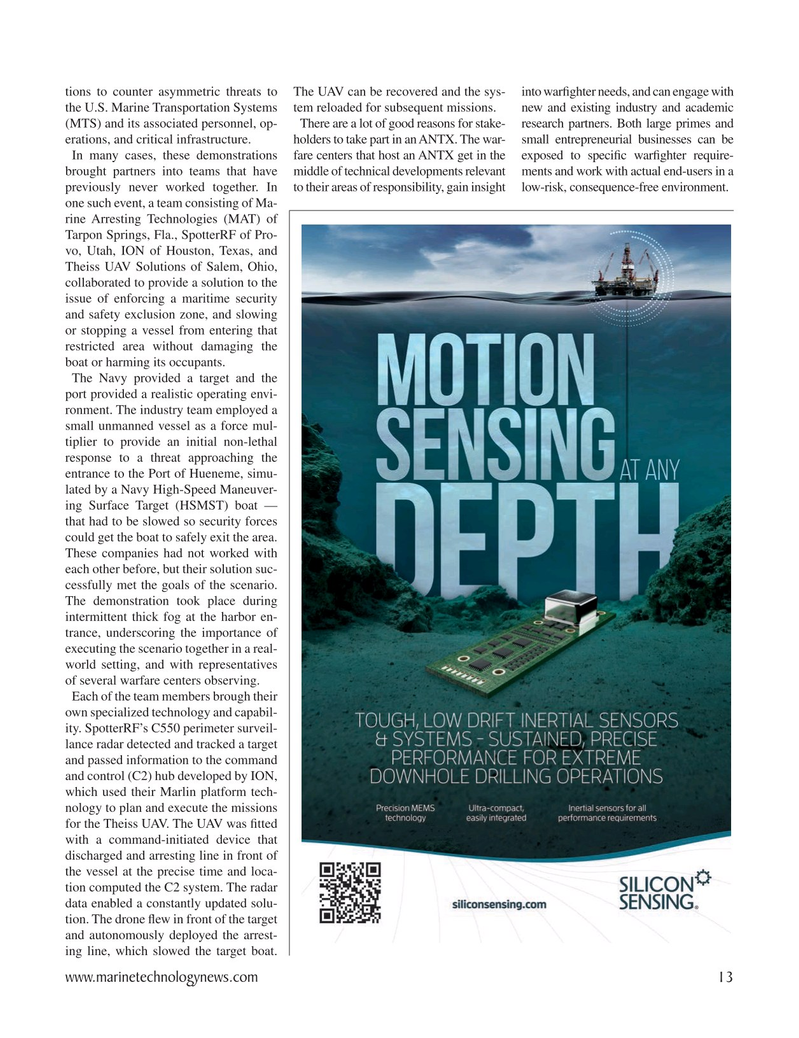
Page 13: of Marine Technology Magazine (November 2021)
Ocean Observation: Gliders, Buoys & Sub-Surface Networks
Read this page in Pdf, Flash or Html5 edition of November 2021 Marine Technology Magazine
tions to counter asymmetric threats to The UAV can be recovered and the sys- into war? ghter needs, and can engage with the U.S. Marine Transportation Systems tem reloaded for subsequent missions. new and existing industry and academic (MTS) and its associated personnel, op- There are a lot of good reasons for stake- research partners. Both large primes and erations, and critical infrastructure. holders to take part in an ANTX. The war- small entrepreneurial businesses can be
In many cases, these demonstrations fare centers that host an ANTX get in the exposed to speci? c war? ghter require- brought partners into teams that have middle of technical developments relevant ments and work with actual end-users in a previously never worked together. In to their areas of responsibility, gain insight low-risk, consequence-free environment.
one such event, a team consisting of Ma- rine Arresting Technologies (MAT) of
Tarpon Springs, Fla., SpotterRF of Pro- vo, Utah, ION of Houston, Texas, and
Theiss UAV Solutions of Salem, Ohio, collaborated to provide a solution to the issue of enforcing a maritime security and safety exclusion zone, and slowing or stopping a vessel from entering that restricted area without damaging the boat or harming its occupants.
The Navy provided a target and the port provided a realistic operating envi- ronment. The industry team employed a small unmanned vessel as a force mul- tiplier to provide an initial non-lethal response to a threat approaching the entrance to the Port of Hueneme, simu- lated by a Navy High-Speed Maneuver- ing Surface Target (HSMST) boat — that had to be slowed so security forces could get the boat to safely exit the area.
These companies had not worked with each other before, but their solution suc- cessfully met the goals of the scenario.
The demonstration took place during intermittent thick fog at the harbor en- trance, underscoring the importance of executing the scenario together in a real- world setting, and with representatives of several warfare centers observing.
Each of the team members brough their own specialized technology and capabil- ity. SpotterRF’s C550 perimeter surveil- lance radar detected and tracked a target and passed information to the command and control (C2) hub developed by ION, which used their Marlin platform tech- nology to plan and execute the missions for the Theiss UAV. The UAV was ? tted with a command-initiated device that discharged and arresting line in front of the vessel at the precise time and loca- tion computed the C2 system. The radar data enabled a constantly updated solu- tion. The drone ? ew in front of the target and autonomously deployed the arrest- ing line, which slowed the target boat. www.marinetechnologynews.com 13
MTR #8 (1-17).indd 13 11/23/2021 2:45:20 PM

 12
12

 14
14
